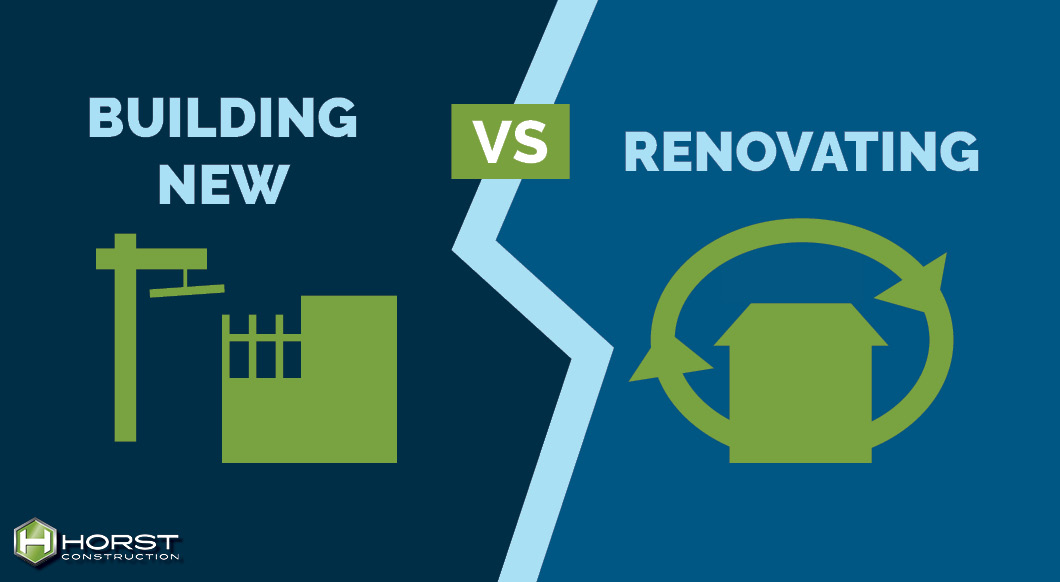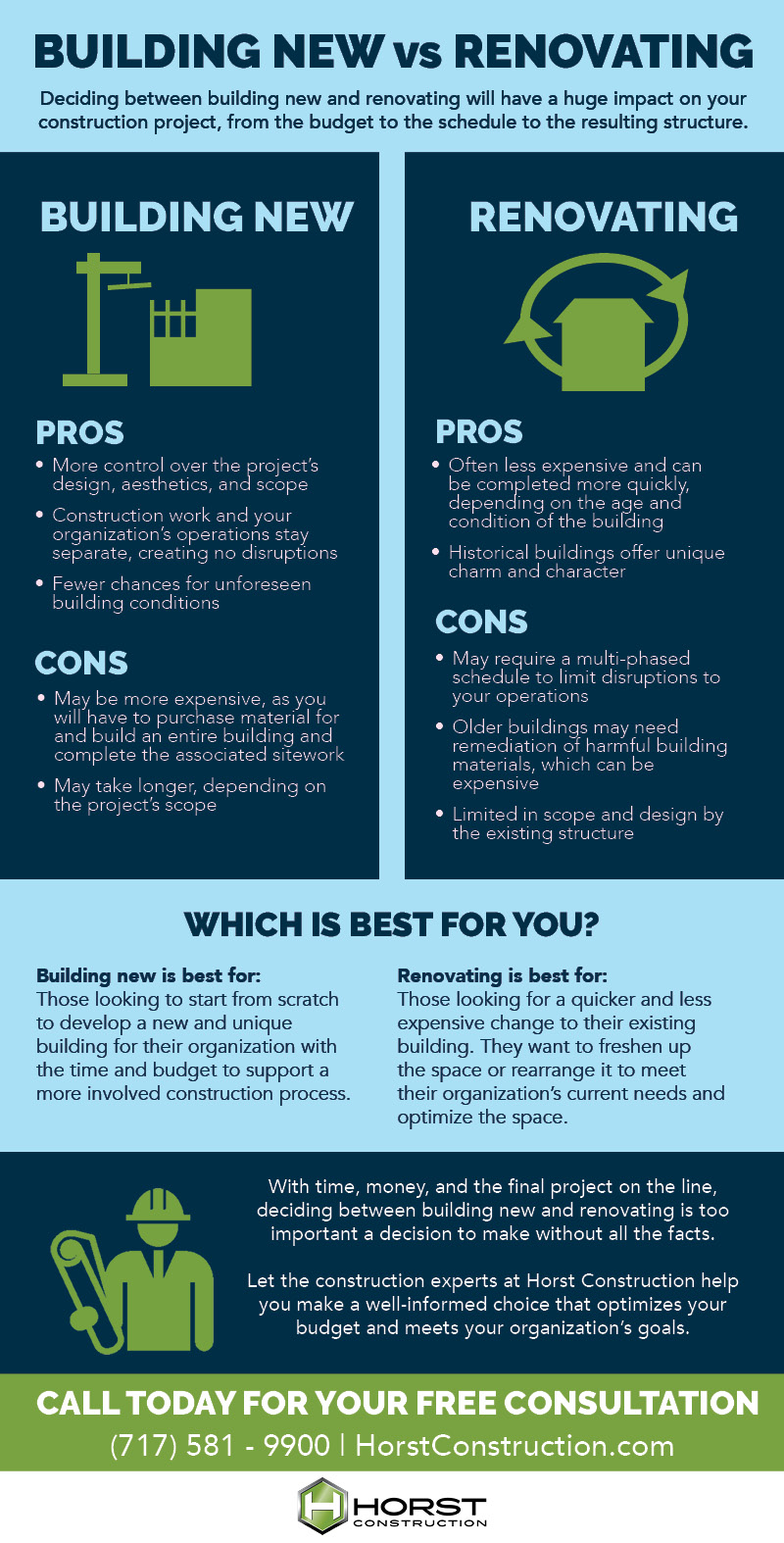
You have three main choices when it comes to a building project: build new, renovate your current space, or acquire and renovate a new space. Deciding between these options will have a huge impact on your project’s budget, schedule, and the resulting structure.
The option that’s right for your project will depend on your goals and the building or property itself. In this article, we’ll lay out the general rules to help you determine when it might be better to build new versus when it is best to renovate.
First, we’ll look at how the option to renovate or build new impacts the three major factors of your project: the cost, the duration, and the design. Then, we’ll sum things up with a quick look at the pros and cons of these choices.
Of course, nothing can replace a one-on-one chat with a construction professional. No matter what stage of the planning process you’re in, we’d love to talk to you about your specific project and goals. Click here to contact us for a free consultation.
 Which is the Most Cost-Effective?
Which is the Most Cost-Effective?
Cost is one of the most influential factors in a construction project. We all want to get the most for the money we have to spend. When it comes to choosing whether to build new or to renovate, the decision often comes down to which one makes more sense financially.
The Price of Building New
It may seem intuitive that starting with a fresh plot of land and erecting a new building will be the more costly option. In exchange for a clean slate, you’ll be responsible for all the sitework, the installation of the utilities, and the construction of the structure itself from the foundation to the exterior finishes.
Because building new typically includes a more complex scope of work, more man hours, and more materials, it’s going to be the more expensive option. However, there are some instances where renovations can become more expensive.
The Price of Renovations
With repurposing an existing space, you’ll be responsible for the cost of changing the structure to suit your needs. You’ll also be responsible for upgrading the existing building per modern ADA, health, and safety codes. Some of the features from the existing building can be left as-is, depending on how extensive the renovations are. These portions help keep the cost of renovating lower than many new builds.
However, this won’t always be the case. Generally, the older the building, the more it will cost to renovate. Renovations also leave room for the unexpected, meaning your construction team can’t be perfectly sure of what conditions or surprises they’ll run into once construction begins, which could potentially add cost and time to your project. This can especially be the case if toxic building materials, like lead paint or asbestos, were used in the original construction and need to be mitigated.
However, there may be grants or assistance available that can help lower the cost of refurbishing an underused or blighted site. This can be great for the community and better for the environment, so governments and outside foundations may provide financial incentives to encourage developers and businesses to reclaim these properties.
On the other hand, if you’re just looking to freshen up and revitalize your existing space, especially if it was constructed or updated in the past few decades, renovations will likely be the more affordable option.
As a rule of thumb, renovations are often less expensive than building new. However, if you’re renovating a particularly old building that’s seen better days, this may not be the case.
Which Has a Quicker Project Duration?
The duration of the project is going to vary based on the scope of the project, the condition of the existing building (if renovating), and whether your organization’s operations will need to continue alongside construction activities.
The Duration of a New Construction Project
The duration of a new construction project will often be greater than the duration of a renovation due to the sheer amount of work that needs to be executed. With new construction, you’re responsible for carving out a site and foundation for the building. You’ll need to lay all the utility equipment. You’ll need to build the entire structure from the ground up and complete it with finishes.
The Duration of a Renovation
When compared to new construction, renovations can often be the quicker option. Because you’re not starting from scratch, and many of the necessary building elements are already in place and can be integrated into the renovated building, your construction team will have much less work to do.
That said, there are some instances where this won’t be the case. Particularly with older and historical buildings, project durations can span beyond the time it would have taken to build new. Especially if there are harmful building materials that need to be mitigated.
One important factor to consider when choosing whether to renovate or build from scratch is the impact it would have on your operations. If you’re renovating the facility you’re currently operating out of, you may have to adjust your operations to safely work alongside your construction team. At Horst Construction, we’ve completed several renovation projects that utilized a multi-phased schedule developed to prioritize your ongoing operations. We’ll work with you to create a project plan that allows your organization to continue operating while still getting our job done efficiently and safely.
In most cases, it will be faster to renovate an existing building over building a new one. However, this may not be the case if the building that’s being renovated is particularly old or in need of remediation work.
Which Option Results in a More Attractive and Functional Design?
The aesthetics of a building send a powerful message to those inhabiting or visiting it. Plush finishes can communicate the feeling of comfort. Sleek, modern minimalism can communicate efficiency. The layout of your facility matters as well. When investing in a construction project, you want to be sure you are happy with the result, both in how it looks and how it functions.
Designing a New Building
In most cases, building new gives you the most control over how the result will look and how the building will function. With a new building, you can design the project exactly to your needs – from size and layout to energy efficiency and parking.
Re-Designing a Renovated Building
With renovations, you are a little more limited to the confines of the existing structure. While you can certainly move walls, add on to the structure, and make the building suit your needs, you won’t be building your vision from the ground up.
That said, renovated and repurposed buildings can have a unique character or charm to them not easily matched with new construction, especially with older sites. This charm can go a long way in creating an attractive space that customers, clients, members, or employees will want to be around. Think 19th-century factories with brick walls and floor-to-ceiling windows repurposed into apartments, or unique old houses bursting with character turned into an office.
However, beauty is in the eye of the beholder, and functionality is dependent on your organization’s unique needs for the new space.
In most cases, new construction allows for the most control over the design. With a renovation, you’re somewhat confined by the existing structure, but historical buildings can offer a uniquely attractive aesthetic.
Pros and Cons: New Construction vs Renovations
To sum it up, the right decision between new construction and renovating is going to depend on the scope of your project.
Overall, building new gives you more control over the project – you can easily tailor it to your exact needs and goals. However, new construction could be more costly and take longer than renovating a moderately new building.
With the renovation of a facility, you’ll be somewhat bound to the existing structure, unlike the unfettered options new construction gives you. However, if you’re just looking to refresh your existing space, renovating will likely be the less costly option.
Deciding between renovating an existing building or starting with new construction is a difficult decision, but it’s an important one. It will guide nearly every other decision you make throughout the building project and will impact both budget and schedule.
At Horst Construction, we’ve helped many clients make this decision throughout our 125+ years in the industry. We’d love to talk about your project and help you determine the path that’s right for you.


